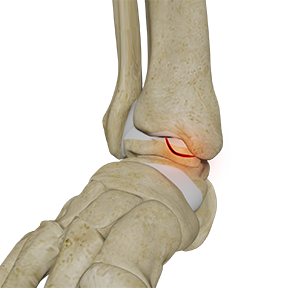Introduction:
An osteochondral lesion of the talus (OLT) is an area of abnormal, damaged cartilage and bone on the top of the talus bone (the lower bone of the ankle joint). This condition is also known as osteochondritis dissecans (OCD) of the talus or a talar osteochondral lesion (OCL). It is often associated with a traumatic injury such as a severe ankle sprain. However, it can also occur from chronic overload due to malalignment or instability of the ankle joint.

Non-Operative Treatment
Non-operative treatment can be successful for non-displaced talar OLTs, especially if the condition is recognized and treated early, and the lesion is relatively small. Younger patients, particularly growing children or adolescents, have a much better chance of healing an OLT compared to adults. There are several non-operative management options for the treatment of osteochondral lesions, including:
- Cast immobilization: If the OLT occurs following an acute injury, initial immobilization in a cast for 4-6 weeks can help reduce stress on the OLT and allow healing. This treatment approach can be initially attempted in non-displaced OLTs
- Physical therapy: working on strengthening the muscles around the ankle, range of motion of the ankle, and balancing (proprioception)
- Protective braces (ex. Ankle Lacer) to decrease stress can also be utilized
In younger patients, this condition has the potential to heal, making it possible to treat acute non-displaced talar OLTs with immobilization in a cast or CAM walker.

- NWB for first 2-4 weeks (physician’s preference) in the younger, athletic population, smaller lesions (less than 1 cm) of central or posterior talus.
- Patients who have anterior talar lesion, smokers, high BMI, increased age, lesion greater than 1 cm may be NWB up to 6 weeks.
- Ankle range of motion is limited to a gentle active range of motion in the sagittal plane for six weeks.
- Running typically occurs around 12 weeks – initiate running protocol at 12 weeks.
- Expect slower progressions with larger lesions greater than 1 cm and if a micro-fracture procedure was performed.
- The return to sport timeframe is expected to be around 4-6 months.
Injections:
HA
PRP


